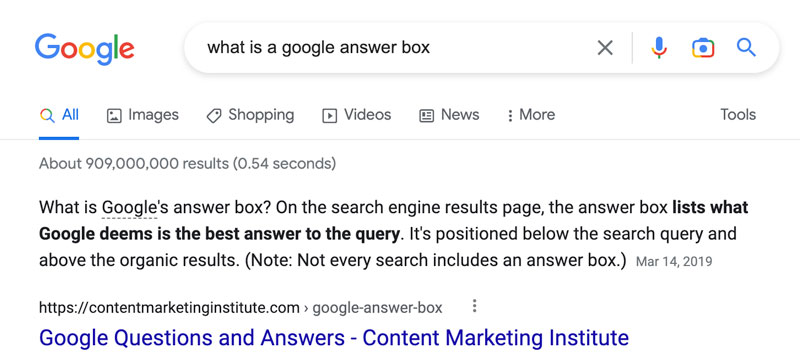Everyone and their mother look to Google for all of life’s questions. If you’re a business owner, having a high search engine ranking on Google is the best way to gain more traffic. The Google answer box is the ideal place for your website to be.
What is a Google Answer Box?
Whenever you look to Google for help on a recipe, new purchase, or literally any other inquiry under the sun, the  Google answer box is typically the first thing you see. It’s the list, paragraph, or image that Google deems the best answer to whatever question you searched. Sometimes, it’s also referred to as “position zero,” “featured snippet,” and “instant or quick answers.”
Google answer box is typically the first thing you see. It’s the list, paragraph, or image that Google deems the best answer to whatever question you searched. Sometimes, it’s also referred to as “position zero,” “featured snippet,” and “instant or quick answers.”
The featured snippet is styled differently than other results on that page. For example, the font usually is more prominent, highlighted with a shadow around it, and the answer text is positioned above the source URL. While there are thousands of possible features on Google’s SERPs (search engine results pages), the Google answer box is unique because it provides an adequate answer to the user’s query.
Why are Google Answer Boxes Important?
Since it’s the first answer to pop up on a search, it’s the ideal place for gaining the most traffic possible. Ranking number one on Google is fantastic but ranking in position zero is even better. These answer boxes help solve users’ problems and improve webmasters’ search engine ranking.
If users decide to click the URL under the answer box, that will still count as organic traffic to the website. The only difference is the presentation of knowledge on the SERP. If your site makes it to instant or quick answers, you will accumulate a higher search engine ranking.
How to Get in the Google Answer Box
Google gives people access to a world of knowledge right at their fingertips. So, how do you set your information apart from the rest? The best way to rank in position zero is by:
1. Doing keyword research
2. Researching competitors
3. Planning and developing your content
 Researching Keywords to Increase Search Engine Ranking
Researching Keywords to Increase Search Engine Ranking
One of the best ways to gain more traction on your blog or website is by using the right keywords. What are people searching for? What language do customers use when asking questions?
When you can hone in on how people ask their questions, you can build a keyword list around those phrases. Also, look to Google for clues through its people-also-ask and searches-related-to content to add to the list. The more accurate your keyword list is, the more traction you will gain.
How to Research Your Answer Box Competitors
To become a featured snippet on Google, you need to rise above the competition. However, your competition in business and the real world won’t necessarily be the same as your research competitors.
When you start the competitive research process, refer to your keyword list. Your competitor in search is the brand in the Google answer box for the keyword you want to rank for. Your competitor for position zero is whatever brand or website currently has the featured snippet for the keyword you want to rank for.
Take note of the format; is it a bulleted list, paragraph, or table? How long are the answers—are they one sentence or several? What phrases are used? It will be essential to consider your competitors when planning your own content.
Evaluate what they’re doing well and what they might be missing. Keep an eye out for a definition they may have missed or an acronym they might not have spelled out. Then, you can fill in those missing pieces.
How to Plan, Develop, and Optimize Your Content
 You should make sure you include the question in your blog or article. Make it a heading so google can recognize the question you’re answering. The question should be an H2 (second level) header, and the answer should follow below the heading.
You should make sure you include the question in your blog or article. Make it a heading so google can recognize the question you’re answering. The question should be an H2 (second level) header, and the answer should follow below the heading.
When writing your content, use similar formats to your competitors. If Google seems to like a paragraph for your keyword search, use a paragraph. If Google prefers a list, put it in a list. Getting listed on the Google answer box for competitive keywords significantly improve visibility and increase your search engine ranking.
Once you do keyword research, investigate your competitors, and plan your content accordingly, you’ll be on track to position zero.
